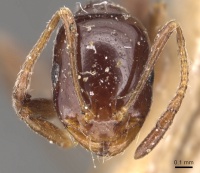Monomorium hesperium
| Monomorium hesperium | |
|---|---|

| |
| Scientific classification | |
| Kingdom: | Animalia |
| Phylum: | Arthropoda |
| Class: | Insecta |
| Order: | Hymenoptera |
| Family: | Formicidae |
| Subfamily: | Myrmicinae |
| Tribe: | Solenopsidini |
| Genus: | Monomorium |
| Species: | M. hesperium |
| Binomial name | |
| Monomorium hesperium Emery, 1895 | |
| Subspecies | |
| |
| At a Glance | • Ergatoid queen |
Identification
Distribution
Latitudinal Distribution Pattern
Latitudinal Range: 28.733333° to 27.75°.
| North Temperate |
North Subtropical |
Tropical | South Subtropical |
South Temperate |
- Source: AntMaps
Distribution based on Regional Taxon Lists
Palaearctic Region: Canary Islands (type locality).
Distribution based on AntMaps
Distribution based on AntWeb specimens
Check data from AntWeb
Countries Occupied
| Number of countries occupied by this species based on AntWiki Regional Taxon Lists. In general, fewer countries occupied indicates a narrower range, while more countries indicates a more widespread species. |

|
Estimated Abundance
| Relative abundance based on number of AntMaps records per species (this species within the purple bar). Fewer records (to the left) indicates a less abundant/encountered species while more records (to the right) indicates more abundant/encountered species. |

|
Biology
Castes
Bolton (1986) described ergatoid queens in this species, and referred to them as 'apterous queens' because of small degree of thorax simplification
Nomenclature
The following information is derived from Barry Bolton's Online Catalogue of the Ants of the World.
- hesperium. Monomorium hesperium Emery, 1895b: 66, fig. 3 (w.) SPAIN (Canary Is).
- Type-material: syntype workers (number not stated).
- Type-locality: Spain: Canary Is (Ch. Alluaud).
- Type-depository: MSNG.
- Espadaler & Agosti, 1985: 295 (q.).
- Combination in Monomorium (Xeromyrmex): Emery, 1922e: 177.
- Status as species: Emery, 1908h: 680; Emery, 1922e: 177; Wheeler, W.M. 1927g: 106; Wellenius, 1955: 7; Ettershank, 1966: 89; Báez & Ortega, 1978: 190; Barquin Diez, 1981: 155; Espadaler & Agosti, 1985: 295; Bolton, 1987: 294; Hohmann, et al. 1993: 153; Bolton, 1995b: 262; Borowiec, L. 2014: 120 (see note in bibliography).
- Distribution: Spain (Canary Is).
- Current subspecies: nominal plus lanzarotense.
Unless otherwise noted the text for the remainder of this section is reported from the publication that includes the original description.
Description
Type Material
Bolton (1987) - Holotype worker, Canary Islands: no loco (Alluaud) (Museo Civico di Storia Naturale, Genoa) [examined].
References
- Arcos González, J. 2021. New records of the exotic black little ant Monomorium carbonarium in the Iberian Peninsula and discovery of the ergatoid queen (Hymenoptera: Formicidae). Fragmenta Entomologica 53: 69-74 (doi:10.13133/2284-4880/432).
- Bolton, B. 1986. Apterous females and shift of dispersal strategy in the Monomorium salomonis-group (Hymenoptera: Formicidae). Journal of Natural History 20: 267-272.
- Bolton, B. 1987. A review of the Solenopsis genus-group and revision of Afrotropical Monomorium Mayr (Hymenoptera: Formicidae). Bulletin of the British Museum (Natural History). Entomology. 54: 263-452. (page 294, see also)
- Borowiec, L. 2014. Catalogue of ants of Europe, the Mediterranean Basin and adjacent regions (Hymenoptera: Formicidae). Genus (Wroclaw) 25(1-2): 1-340.
- Emery, C. 1895n. Sopra alcune formiche della fauna mediterranea. Mem. R. Accad. Sci. Ist. Bologna (5)5:59-75 (page 66, fig. 3 worker described)
- Espadaler, X.; Agosti, D. 1985. Monomorium hesperium Emery: description de la femelle (Hymenoptera, Formicidae). Mitt. Schweiz. Entomol. Ges. 58: 295-297. (page 295, queen described)
References based on Global Ant Biodiversity Informatics
- Bolton B. 1987. A review of the Solenopsis genus-group and revision of Afrotropical Monomorium Mayr (Hymenoptera: Formicidae). Bulletin of the British Museum (Natural History). Entomology 54: 263-452.
- Borowiec L. 2014. Catalogue of ants of Europe, the Mediterranean Basin and adjacent regions (Hymenoptera: Formicidae). Genus (Wroclaw) 25(1-2): 1-340.
- Emery, C. "Beiträge zur Monographie der Formiciden des paläarktischen Faunengebietes. (Hym.) Teil V. Monomorium." Deutsche Entomologische Zeitschrift 1908 (1908): 663-686.
- Emery, C. "Sopra alcune formiche della fauna mediterranea." Memorie della Reale Accademia delle Scienze dell'Istituto di Bologna (5)5 (1895): 59-75 [pagination of separate: 291-307].
- Espadaler, X., and Donat Agosti. "Monomorium hesperium Emery: description de la femelle." Mitteilungen der Schweirzerischen Entomologischen Gesellschaft 58 (1985): 295-297.
- Ettershank G. 1966. A generic revision of the world Myrmicinae related to Solenopsis and Pheidologeton (Hymenoptera: Formicidae). Aust. J. Zool. 14: 73-171.
- Hohmann H., F. La Roche, G. Ortega, and J. Barquín. 1993. Bienen, Wespen und Ameisen der Kanarischen Inseln. Veröff. Überseemus. Bremen Naturwiss. 12: 14.
- Santschi, F. "Fourmis d'Espagne et des Canaries." Boletín de la Real Sociedad española de Historia natural (Madrid) 19 (1919): 241-248.
- Schulz, A. "Epimyrma birgitae nova species, eine sozialparasitische Ameisenart (Hym.: Formicidae) auf Teneriffa (Kanarische Inseln, Spanien)." Beiträge zur Entomologie 44 (1994): 431-440.
- Wellenius, O. H. "Entomologische Ergebnisse der finnländischen Kanaren-Expedition 1947-1951. No. 10. Formicidae Insularum Canariensium. Systematik, Ökologie und Verbreitung der Kanarischen Formiciden." Commentationes Biologicae Societas Scienitarum Fennica 15(8) (1955): 1-20.
- Wheeler, W. M. "The ants of the Canary Islands." Proceedings of the American Academy of Arts and Sciences 62 (1927): 93-120.

